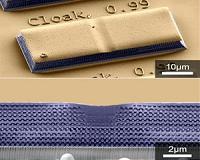 |
Fribourg, Switzerland (UPI) May 24, 2011 U.S. and Swiss scientists say they have developed a polymer-based coating that can heal itself when placed under ultraviolet light for less than a minute. The "metallo-supramolecular" polymer coating has garnered interest from many parties, including the U.S military, Swissinfo.com reported. "For the moment it's still at the basic research level," Christoph Weder, director of Fribourg University's Adolphe Merkle Institute, said. "We are not looking to develop products for the market but concepts and tools that can then develop commercially viable materials. That's the way our [nanoscience] institute functions." He declined to comment on the U.S. military's particular interest in the material. "I don't want to speculate on their interest in supporting this particular project, but the people involved were really devoted to basic research," said Weder, a Swiss professor of polymer chemistry and materials who has worked for many years in the United States. The new material has many potential practical applications from tactile computer screens to everyday consumer items like cars, floors and furniture that get easily scratched. "This is ingenious and transformative materials research," said Andrew Lovinger, polymers program director at the National Science Foundation's Materials Research Division.
Share This Article With Planet Earth
Related Links Space Technology News - Applications and Research
 Karlsruhe Invisibility Cloak: Disappearing Visibly
Karlsruhe Invisibility Cloak: Disappearing VisiblyKarlsruhe, Germany (SPX) May 24, 2011 "Seeing something invisible with your own eyes is an exciting experience," say Joachim Fischer and Tolga Ergin. For about one year, both physicists and members of the team of Professor Martin Wegener at KIT's Center for Functional Nanostructures (CFN) have worked on refining the structure of the Karlsruhe invisibility cloak to such an extent that it is also effective in the visible spectral rang ... read more |
|
| The content herein, unless otherwise known to be public domain, are Copyright 1995-2010 - SpaceDaily. AFP and UPI Wire Stories are copyright Agence France-Presse and United Press International. ESA Portal Reports are copyright European Space Agency. All NASA sourced material is public domain. Additional copyrights may apply in whole or part to other bona fide parties. Advertising does not imply endorsement,agreement or approval of any opinions, statements or information provided by SpaceDaily on any Web page published or hosted by SpaceDaily. Privacy Statement |